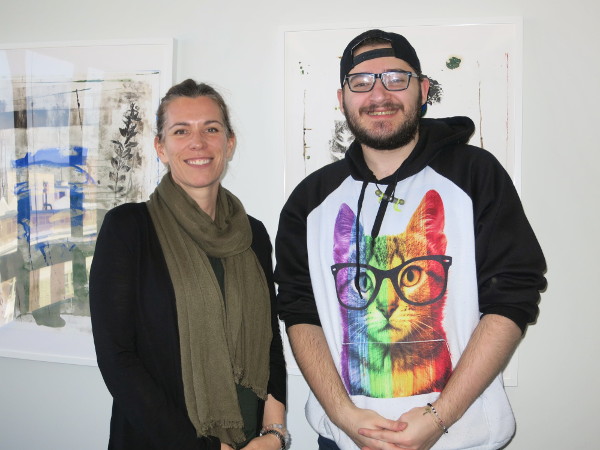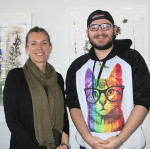Sociology Student Examines Queer Sexuality in Video Games
In the introduction to his Sociology Senior Seminar paper, Steven Bagoly breathlessly tells the tale of star-crossed lovers sharing a sweet, but fleeting, kiss during a zombie apocalypse.
The story of Ellie and Riley’s journey from childhood friends to lovers facing insurmountable odds has a classic structure common to great stories throughout the ages. But in a notable departure from tradition, Ellie and Riley are a same-sex couple who fall in love in a story-based video game, a medium that has lagged behind other art forms in its embrace of diverse characters.
Bagoly sought to understand how the representation of queer characters in single player, story-based video games affect both the experience of gamers and the marketability of games. “Queer” is used as an umbrella term for anyone who identifies as lesbian, gay, bisexual, transgender and queer or other non-hegemonic sexualities or genders (LGBTQ+).
Bagoly hoped to legitimize the study of video games as a valid subject of scholarly inquiry and test his assumption that LGBTQ+ gamers sought to see themselves represented in the virtual worlds they frequented, as he did.
Guiding him along the way, Associate Professor Judith Halasz helped Bagoly define his focus and provided support through the various stages of the project, which included a class presentation.

All seminar students conducted original research, collected and analyzed quantitative data, contextualized their work in the scholarly literature, and met for frequent check-ins during office hours. “The projects are very much student-driven, within the structure,” said Halasz. “These are their projects, and I am mindful that I’m the mentor, not controlling what they do.”
Bagoly drew from scholarly research on the identity of queer gamers (gaymers) and video game enthusiasts as a whole, as well as other works that explored how different types of media, including television and film, handled the representation of minority groups and diversity when telling a story.
To gain a better understanding of how video games marginalize or highlight LGBTQ+ characters, Bagoly completed a statistical analysis of 167 video games featuring queer content from the period of 1986 to 2017.
Bagoly categorized queer characters into the subgroups of playable and non-playable characters to assess the centrality of their roles to the video game’s narrative. While some games featured explicitly LGBTQ+ protagonists, others included playable characters with optional queer storylines (such as same-sex romances) that rendered it possible to play the game “straight.” Non-playable queer characters took the forms of antagonists or minor characters with limited screen time.
Bagoly found that in games featuring queer content, playable LGBTQ+ characters came to inhabit a more central role in the games’ narratives. Of the games examined, only eight included explicitly queer, playable characters between the years 1980-2009, while that number more than doubled, to 21, between the years 2010-2015.
To assess the games’ marketability, Bagoly compared the critical rating and player rating scores of games to determine if those featuring queer characters were considered well-made and well-liked within gaming circles.
Bagoly found that some of the most critically acclaimed games in the last five years have queer representation, countering the notion that including LGBTQ+ characters in games poses a financial risk.
“The Last of Us” (2013), a horror survival game featuring three gay characters, one of whom the gamer controls for an extended period of time, garnered over 200 awards for character design, storytelling and sound. “Stardew Valley” (2016) scored a perfect 10 out of 10 review on Steam, a popular platform that allows gamers to rate video games. The game allows the playable character to marry and have children with a choice of five male characters and five female characters.
To his surprise, Bagoly discovered in his research on LGBTQ+ gamers that most consider having queer characters in video games “more of a bonus” than a determining factor in selecting what games to play. Though Bagoly acknowledged that video games are still widely produced by and for straight, white males, he believes the industry can comfortably push the boundaries of representation without suffering financial consequences, and in the process, expand the industry’s fan base.
“I was trying to argue that it was good to have representation in games and queer people want to see representation, but after doing more research into it, I found that games were not losing value when they had queer representation,” noted Bagoly. “They might not have been making a statistically higher amount of money compared to games in a similar genre or a similar setting, but they weren’t making less money, and I think that’s a really important point; they were able to compete.”
Recognizing the high quality of his work, Halasz encouraged Bagoly to present his findings at the undergraduate poster session of the February Eastern Sociology Society Meeting in Baltimore. There, Bagoly found a receptive audience for his research.
Bagoly laments that video games are often viewed as an immature artistic medium, and believes they can tell dynamic stories that embrace sociopolitical themes. He likened the amplification of LGBTQ+ characters in video games to efforts to include female characters and characters of color in other forms of media, and sees a nascent revolution taking shape.
“I might not make the biggest change of the century for queer gamers, but I got my voice out there,” said Bagoly of his recent conference experience. “I was able to create this research, and I feel like that’s still a really huge accomplishment – to have something that I can say we were talking about this before the big revolution of queer gamers.”

